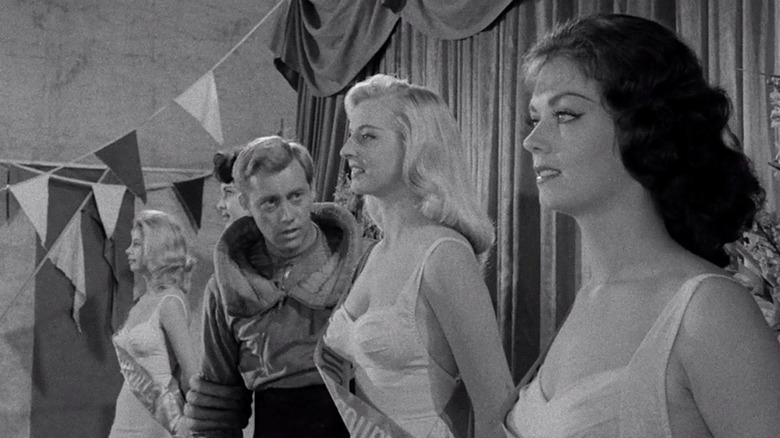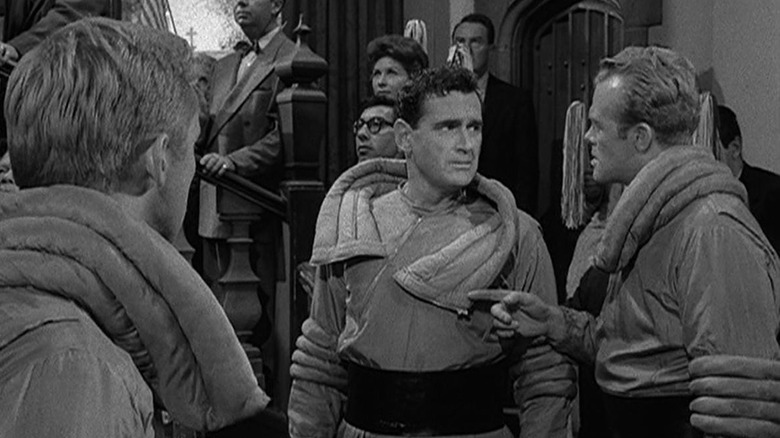How The Twilight Zone Froze An Entire Town Of Real Actors In Time
"The Twilight Zone" has been revived three times on three different networks, it's been adapted into a feature film (co-directed by Steven Spielberg, Joe Dante, George Miller, and John Landis, no less), a TV movie (don't sleep on it! Richard Matheson, Jack Palance, Amy Irving, and James Earle Jones came together to make this one), a long-running radio drama, a series of comics, novels, amusement park rides, and even more. But I bet when you see that title you think of the black-and-white series hosted by Rod Serling, don't you?
Really, how could you not? It's no knock on any of the variations that followed; the original run of episodes that spanned from 1959 to 1963 is just that excellent. Sure, there are a few duds, but "The Twilight Zone" was simply paradigm-shifting, zeitgeist-seizing, landmark television, in its time and now. Of course we wouldn't have "American Horror Story" (by this point, would that be a huge loss ...), but filmmakers from David Cronenberg to Martin Scorsese to Karyn Kusama have all professed to be inspired by the series, some even to kickstart their careers. That kind of influence is hard to even tabulate.
For an example of how "The Twilight Zone" captured America's imagination with gripping storytelling and innovative technical mastery, look no further than the season one episode "Elegy." For the 1960 episode, an equally prolific writer and director for the series (Charles Beaumont and Douglas Heyes) needed to freeze an entire town, but refused to employ dummies. What you see in "Elegy" is live, immobilized flesh, and how they pulled it off is a story more interesting than constantly yelling at extras to stand still.
Capturing stillness
"Elegy" follows a team of astronauts in the year 2185 who have to make an emergency landing on an asteroid millions of miles from Earth. They find that the asteroid has an atmosphere, climate, and strength of gravity strikingly similar to our planet, but what they find is far from life. Or, not far enough. The entire town, including a farm, town square, and most memorably a beauty contest, is frozen solid. Every single person is completely motionless. Eventually, a kindly robot caretaker (Cecil Kellaway) informs them that life was wiped out on Earth in 1985, that these are the lifeless bodies of rich people who've paid to live out their eternal death in a manufactured fantasy land, and that, oh! He's poisoned them. The astronauts become the newest attraction at the "Happy Glades" resting place.
In Marc Scott Zicree's "The Twilight Zone Companion," director Heyes noted that it was impossible to expect dozens of extras to truly suspend all their most minute movements long enough to shoot. So he had to get creative: "If you'll notice on 'Elegy,' when you see those characters, the camera is almost always in movement, moving backwards and forwards, panning, and so forth." A still camera would ironically pick up the tiniest movements in still bodies. But a moving camera would actually blend movement back into the stillness.
Heyes and Beaumont had a disagreement on one of the episode's main setpieces. Beaumont had originally written a car race, which Heyes, an avid racing fan, shot down, thinking there was no way to make frozen cars going fast look like anything but normal parked cars. "Charles never liked anything I did with any story he ever wrote," Heyes quipped. He subbed in the beauty contest scene, and a little piece of television history was made.

